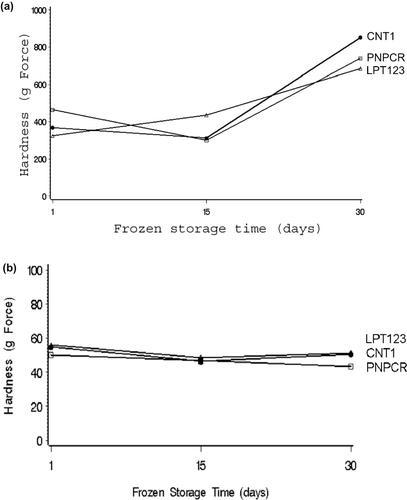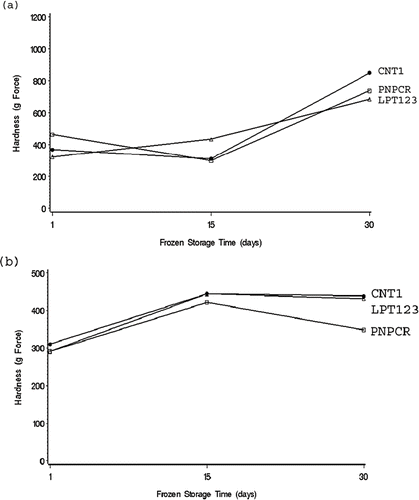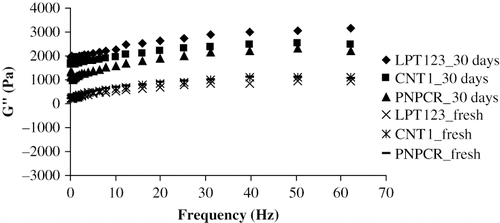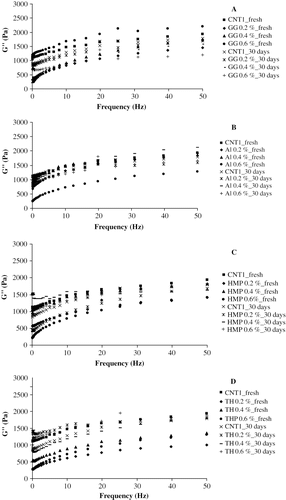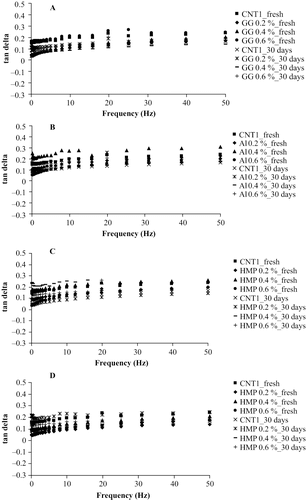Abstract
Changes of rheological and textural properties of gels from three Thai rice varieties containing di/polysaccharides were evaluated during frozen storage. Gel hardness of all reheated samples increased after 15 days frozen storage. At 30 days of frozen storage, all gels showed increased in G′, G″, and tan δ. Addition of the additives in Chainat1 resulted in changes of pasting properties of starch, hardness and rheology of frozen and reheated gels. Alginate, high methoxyl pectin, and trehalose at 0.4–0.6% in Chainat1 starch increased G′ of reheated gels but guar gum at 0.6 % reduced G′, G″.
INTRODUCTION
Rice is a staple food in Asia and is exported in the form of milled rice and other rice products to different countries around the world. Rice products include rice flour, glutinous rice flour, noodles, crisp bread, gingerbread, sweet biscuits, waffles, and wafers. Thailand rice products that show continuously high growth in export value are glutinous rice flour, rice noodles, and snacks.[Citation1] Export statistics of rice noodles to the United States and Canadian show increases of 30.45% and 39.72%, respectively, during the period 2002–2006.[Citation2] Some rice noodles such as dried and instant noodles have acceptable cooking quality. However, some specific rice noodles, such as large strand or sheet noodles, lose some of the desirable attributes when dried, and therefore, are exported as fresh noodles. Prepared frozen foods have become more popular with steady increase in consumption in developed countries because of their convenience and variety of selection. A number of popular foods in Asia are frozen for export markets. Frozen rice noodles could overcome some of the loss in cooking quality caused during the drying process; however, changes in properties and quality during processing and frozen storage need to be investigated in order to assess the improvement of the quality of frozen rice noodles. Rice noodle quality and structure depends on gelatinization and retrogradation properties of starch and amylose content. Various high-amylose rice varieties are generally used for noodle processing.[Citation3]
Amylose/amylopectin ratio, molecular weight, and molecular fine structure influence the physicochemical properties of starch. RVA peak viscosity, swelling power, crystallinity, and enthalpy of gelatinization of rice starches decreased with increasing amylose content of the starches.[Citation4] However, set back viscosity increased with amylose content suggesting that amylose reassociation played an important role in starch retrogradation.[Citation4] Starch retrogradation affected hardness of the gel mixtures after 3 and 7 days of storage at 4 ± 0.5°C. Hardness of starch gel may be related with the elastic structure of starch gel.[Citation5] Amylose content affected gel elastic structure and G′ of the complex gel increased during 12 h at room temperature. The elastic structure (junction zones) of the starch gel (mainly amylose) could be strengthened by complex formation and further reinforced during storage.[Citation6] Differences in G′and G″were attributed to differences in amylose contents in starches. High amylose starch forms stronger gel structure, as was evident from its lowest swelling power, while low amylose starch swells more readily during heating, resulting in a less rigid gel.[Citation7]
Amylopectin is the major component of the most starches and its branch chain length distribution contributes to gelatinization temperature, enthalpy and pasting properties.[Citation8] While amylose retrogradation proceeds fast (short-term, less than one day), amylopectin retrogrades slowly (long-term, several weeks) and contributes to rheological and structural changes of starch systems.[Citation9] In a study of varying amylose content from 5 to 25% by blending waxy and non-waxy wheat starch, the starch gels containing more waxy starch showed a more rapid development of G′ and higher starch retrogradation rate constant.[Citation10] Retrogradation of starch gels is often enhanced by freezing and thawing treatments. During freezing, the formation of ice crystals can separate gel into fractions, while in thawing the ice crystals melt to form a mixture of water and gel.[Citation11] The highest syneresis value was obtained for amylose rice flour gel, followed by Jasmine rice and waxy rice flour gel.[Citation11] Both, starch retrogradation and ice recrystalization contributed to deterioration of frozen corn starch and wheat flour paste during storage.[Citation12] Guar gum, alginate, and xanthan gum were highly effective in stabilizing sweet potato starch gel against freeze-thawed (9). Xanthan gum (0.3%) appeared to minimize spongy structured formation of frozen gel[Citation12] and reduced paste viscosity.[Citation13] With excess xanthan gum (0.6%) in the starch mixture, the intermolecular interactions could cause an adverse effect by destabilizing and hardening sweet potato gels.[Citation13] The addition of disaccharide (sucrose or trehalose or maltose) could delay the starch gelatinization, and the increased retardation with the increase in sugar concentration. Sugars prevented starch gel from microstructural destruction under freeze/thaw treatment because water mobility was lower and less water was available for the ice formation when sugar was added.[Citation14] Studies with frozen boiled Japanese buckwheat noodles (soba) showed that trehalose 0.55% increased firmness and improved mouthfeel after long term frozen storage.[Citation15]
The aim of this work was to study the changes in rheological and textural properties of starch gels from three high amylose rice varieties grown in Thailand after frozen storage. The effects of food additives at different concentration on these properties and correlation of rheological, pasting and textural properties of the rice starch gels are also reported.
MATERIAL AND METHODS
Materials
Chainat1 (CNT1), LeungPratew123 (LPT123), PlaingamPrachinBuri (PNPCR), varieties of long grain rice grown in Thailand were used. D(+) Trehalose (Sigma-Aldrich, Steinheim, Germany) and guar gum (Sigma-Aldrich, Steinheim, Germany), alginate (Fluka, Switzerland) and high methoxyl pectin, degree of esterification >50% (Billion Rich Gold Co., Ltd., Thailand) were used as food additives.
Isolation of Starch
Starch was isolated from the three varieties according to the methods of[Citation16] andCitation17] with modifications. Rice sample was steeped in 0.4% sodium hydroxide at 5°C for 24 h, wet milled (conventional laboratory stone mill, Thailand), and sieved through a 230 mesh with distilled water (starch: water ratio 1:2, w/w) 5 times. The starch suspension was centrifuged at 4250 × g at 20°C for 10 min. The supernatant was discarded and the starch residue was removed, dried in a tray drier at 35°C for 48 h, and kept in a cabinet desiccator.
Chemical Analysis
Rice starch was analyzed for moisture (AACC, 2000; no. 44–19), protein (AACC, 2000; no. 46–13), fat (AACC, 2000; no. 30–25), ash (AACC, 2000; no. 08–01), and amylose content (AACC, 2000; no.61–03).[Citation18]
Pasting Properties
Pasting Properties of extracted rice starch from 3 varieties and rice starch from CNT1 mixed with 3 levels (0.2, 0.4 and 0.6 % w/w) of food additives (alginate, AL; guar gum, GG; high methoxyl pectin, HMP; and trehalose, TH) were performed by Rapid Visco Analyzer (Newport Scientific Pty Ltd, Warriewood NSW 2102, Australia) using the AACC Standard method (no. 61–02, 2000).[Citation18] Viscosity profiles of the starches and the mixes were studied using 3 g (12% mb) samples and dispensed with water 25.0 g in an RVA sample cup. Test profile of temperature and time contained a 4-step heating-cooling from 50°°C to 95°C to 50°C at rotation 960 rpm: step 1 holding temperature 50°C for 1.0 min; step 2 heating at 95°C for 4.48 min; step 3 heating 95°C for 7.18 min; and step 4 cooling to 50°C for 11.06 min. Total test time used was 12 min, 30 sec. The pasting curve and parameters including peak viscosity, trough viscosity, breakdown, final viscosity, setback, and pasting temperature were recorded using Thermocline for Windows (v. 2.4). The parameters form RVA was reported in RVU units.
Preparation of Starch Gels
Starch gels were prepared with 30% starch slurries (db, w/w) using the extracted rice starches and 20 ml aliquot were transferred in 60 × 15 mm (diameter × height) Petri dishes. Sample gel for texture analysis were 10-mm thick, were steamed using steamer for 20 min and sample gels for rheology analysis were 5-mm thick, were steamed using steamer for 10 min. For frozen samples, gels were frozen using an air blast freezer, packed in plastic zip bag, and stored at −18°C for 30 days.
Rheological Properties
Rheological analysis of flour rice starch gels from three different rice varieties with and without food additives were performed by oscillation test using an AR 1000-N controlled stress/strain rheometer (TA Instruments Newcastle, DE, USA) equipped with stainless steel 4 cm diameter flat plate geometry. Fresh rice gels (unfrozen) and frozen gels stored for 1 and 30 days at −18°C were used to determine the effect of frozen storage on the rheological properties. Frozen gels were thawed for 20 min at 25°C, reheated with steam for 10 min and cooled to room temperature for 20 min before testing. Rice gel samples were loaded on the plate and trimmed. Mineral oil and a solvent trap were used to prevent moisture lost during the test. The gap size was set at 4000 μm and strain 1% for all determinations which were conducted in the linear viscoelastic region (LVR) for each sample. Storage modulus (G′), loss modulus (G″) and tan delta (tan δ) were recorded. Analyses were done in at least six independent replicates.
Instrumental Textural Properties
The effect of frozen storage on the stability of the starch gels were determined by the changes in gel texture using a Texture Analyzer (TA-XT2, Stable Micro System, Surrey, England). Compression tests were carried out at 15 and 70% of the original gel height using a stainless steel cylinder (3-mm diameter) attachment, pre-test speed 2 mm/s, test speed 1 mm/s, and post-test speed 10 mm/s. The texture parameter hardness (gr force) was analyzed by the instrument software. Measurements were done in triplicate.
Statistical Analysis
Chemical composition and pasting properties of starches were analyzed in Completely Randomized Design (CRD). The effects of additives on textural and rheological properties were analyzed using factorial in CRD. Significant differences between treatments and interactions were determined using Duncan's Multiple Range Tests. The SAS software for Windows v. 9.1 (SAS Institute Inc., Cary, NC) was used for all statistic analysis.
RESULTS AND DISCUSSION
Chemical Composition and Amylose Content of Rice Starch
Chemical composition and amylose content of rice starch from the three rice varieties are shown in . Classification of rice starch by amylose content according to the International Rice Research Institute (IRRI) was done using the criteria: low (12–20% amylose), intermediate (20–25% amylose) and high (> 25% amylose).[Citation19] The rice varieties reported in this study, LeungPratew123, Chainat1, and PNPCR, were high amylose content (25.4, 26.9, and 27.9%, respectively). Residual protein content of the three starches was similar averaging 0.42% (). These results are in agreement to previous literature reports of rice starch isolated with alkali solution with residual protein in the range of 0.07–0.42%.[Citation5,Citation20] The rice starches were also similar in fat content and PNPCR rice variety had the highest amylose and ash content (). Amylose content is related to varietal differences and affected by environmental conditions,[Citation21] it could also affect nutritional properties, such as the glycemic index and resistant starch formation.[Citation19]
Table 1 Chemical composition and amylose content of starches from three rice varieties grown in Thailand
Pasting Properties of Rice Starches
Pasting properties of starches were affected by the components of rice starch, such as amylose, protein content, and by cultivar types. Pasting properties () such as trough, break down, final viscosity and pasting temperature of all starches were not significantly different (P > 0.01). However, PNPCR, the highest amylose content starch showed the lowest peak viscosity (249.4 RVU) compared to starches from LPT123 and CNT1 which were similar (288.8 and 279.9 RVU, respectively) PNPCR showed the highest set back. Set back is a measure of recrystallyzation of gelatinized starch during cooling.[Citation22] Set back of RVA viscograms from different types of rice flour were different and amylose rice flour had higher setback and retrogradation than waxy rice flour.[Citation11]
Table 2 Pasting properties of laboratory isolated starches from three rice varieties grown in Thailand
Pasting properties of rice starch with and without food additives
Significant interactions were found between types and levels of food additives (alginate, AL; guar gum, GG; high methoxyl pectin, HMP; and trehalose, TH) on the gelatinization properties and viscosity of the starch paste gel from CNT1 rice. Pasting properties of CNT1 starch and CNT1 starch with the four levels of food additives (0.2–0.6%) were significantly different (P ≤ 0.05) (). Increase of concentration of additives in starch increased most parameters of pasting properties, except breakdown in HMP and AL which was reduced (). Addition of all food additives significantly affected on trough in CNT1 starch by increasing trough from 138.0 up to 189.6 RVU. CNT1 starch with 0.6% alginate gave the highest trough (189.6 RVU), the lowest breakdown (39.9 RVU), the highest final viscosity (357.7 RVU), the highest setback (128.1 RVU), and highest pasting temperature (80.9°C). However, there was no significant difference in final viscosity and setback between starches with 0.4 and 0.6% alginate. These results suggest that the addition of alginate produced starch mixtures with increased shear stability and increased retrogradation. Addition of guar gum 0.2–0.6% resulted in the highest peak viscosity and breakdown (301.3, 125.6 RVU, respectively), but the lowest setback (35.6 RVU). These results are similar to those reported by Williams and Phillips[Citation23] that the addition of hydrocolloid in starch increased viscosity, increased stability of shear force during heating and stirring and reduced retrogradation of starch. Hydrocolloids such as guar gum have functional properties as gelling agents, thickening agents, and stabilizers. Guar gum and HMP increased stability of starch paste by shear as shown in high trough (). However, all additives in the CNT1 starch showed the increase in stability of starch paste by shear as shown in higher trough compared to the controls for all treatments. All levels of alginate and 0.4–0.6% HMP showed higher setback than the controls. This suggests that the treatments facilitated more extended intermolecular bonding or junction zone formation which are considered the first stage of molecular crystallization or retrogradation. Thus, depending on the desired final texture of a particular rice noodle, alginate, and HMP could be used to increase the elastic behavior of the noodles.
Table 3 Pasting properties of rice starches from Chainat1 (CNT1) with and without food additives using RVA
Instrumental Textural Properties
The texture of the gels was estimated by the maximum force (hardness) during two compression tests at 15 and 70% of the original gel height. The first inflection point of the test reflects the failure of part of the gel structure.[Citation24] Starch gels from the three rice varieties were stored frozen for 1, 15, and 30 days and the changes in hardness were recorded. There was a significant difference (P > 0.01) in hardness during the frozen storage time in both 15 and 70% compression tests of the frozen starch gels. At 30 days of frozen storage time, the hardness of all gels increased (P ≤ 0.01) ( and ) with CNT1 being the hardest gel in both compressions. This was an interesting finding since CNT1 had the lowest set back viscosity compared to the other two samples (). Thus, the firmer gel of CNT1, with more junction zones formed during frozen storage, could not be explained solely on composition. After the gels were frozen, they were thawed, reheated and the hardness determined again. A significant difference in hardness during frozen storage time was observed at 70% compression but not at 15% compression of frozen-thaw-reheated starch gels. This suggests that 70% compression could be more useful when analyzing gel texture. The gels after frozen became harder due to more starch retrogradation, and starch became softer after reheating and harder again after the temperature cooled to room temperature. This can be important for frozen starch-based foods which need to be reheated before consumption. Starch gels may degrade and eventually disintegrate and dissolve reversibly. Gel networks are held together by molecular entanglements and/or secondary forces. All of these interactions are reversible and can be disrupted by heat and changes in physical condition.[Citation25] In our studies, there was no significant difference (P > 0.01) among reheated gels for the three rice varieties at 15% compression. However, there was a significant difference among reheated gels for the three rice varieties when analyzed at 70% compression (P ≤ 0.01). All variety-reheated gels became harder at 15 days compared with 1 day of frozen storage. Gels from both CNT1 and LPT123 were more stable in hardness than those of PNPCR at 30 days of frozen storage. PNPCR reheated gel was similar in hardness to the 1 day frozen storage gel.
Textural Properties of Rice Starch With and Without Food Additives
shows the gel hardness of CNT1 starch gel containing additives and analyzed at 15 and 70% compression. Hardness at 15% compression of most frozen gels including CNT1 increased after 15 and 30 days of frozen storage (). However, most reheated frozen gels reduced in hardness after at 30 days of frozen storage but gel with 0.4% HMP had less reduction compared to all gels (). Most additives reduced hardness analyzed at 70% compression of frozen and reheated gels at 15 and 30 days of frozen storage ( and ) except 0.4% HMP. Addition of 0.4% HMP showed higher frozen gel hardness than control gel (CNT1) at 15 days but similar to control gel at 30 days of frozen storage. However, all additives at 0.4% provided softer reheated gel than control gel after frozen storage.
Figure 3 Starch gel texture of CNT1 rice starch, containing 0.4% (w/w) alginate, guar gum, high methoxyl pectin, and trehalose, as a function of storage time (−18°C). Panel a) frozen gels at 15% compression; b) frozen-reheated gels at 15% compression; c) frozen gels at 70% compression; and d) frozen-reheated gels at 70% compression.
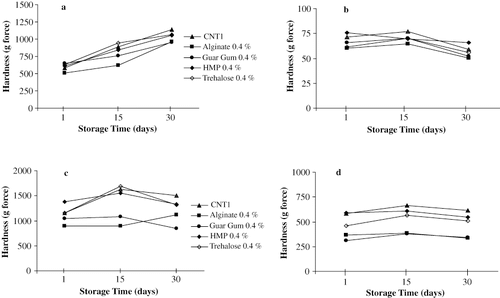
Rheological Properties
For all starch gels, the elastic component G″ () exceeded the viscous component G″ () and both moduli showed little dependence on frequency within the range 0.1–60.0 Hz. For fresh starch gels from the three rice varieties, LPT123, the lowest amylose content showed the lowest G′ but there was no significant difference in G″ for all rice gels. This test showed that the rice starch gels behaved solid-like. This rheological response is more typical of a true gel (physical cross links have a permanent character) than an entanglement network system. Tan δ is a more sensitive parameter than G′ and G″ in probing changes in the viscoelastic nature of polymer gels. The gel of all high amylose content rice starches exhibited tan δ values less than 0.1 within the frequency range 0.1–20.0 Hz, pointing to well-cross-linked network structures (). The results are in agreement with literature reports of rice starches.[Citation26] After 30 days of frozen storage, G′ and G″ increased in all rice gels. The LPT123 gel showed the lowest G′ but highest G″ ( and ). CNT1 reheated gel showed the highest G′ after 30 days of frozen storage. All gels showed significant increase in tan δ (P ≤ 0.01) after frozen storage; and the LPT123 gel showed the highest tan δ (). This result indicates that LPT123 gel became more liquid-like after frozen storage compared with the other gels, and all these gels deteriorated due to ice crystal propagation which limited their shelf life as suggested by.[Citation27]
Figure 4 Storage modulus (G′) of fresh (unfrozen) gels (30%, w/w) and after 30 days of storage at −18°C from high amylose rice starches as a function of frequency. LPT123 = LeungPratew123, CNT1 = Chainat1, and PNPCR = PlaingamPrachinBuri.
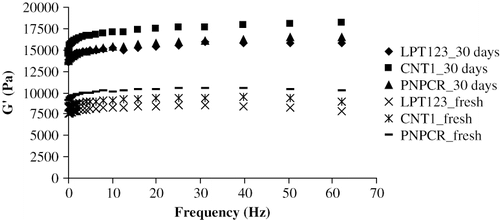
Effects of Food Additives on Rheological Properties of Frozen Gels
There were interactions among all three factors (types of additives, concentration and frozen storage). The addition of alginate, high methoxyl pectin, and trehalose at all levels caused significant reduction (P ≤ 0.05) in G′ and G″ in fresh gels, except the gels with addition of guar gum at 0.6% which caused an increase in G′ and G″ ( and ). For reheated gels after frozen storage for 30 days, most gels showed increase in G′ (P ≤ 0.05) but not in G″ (P > 0.05). The significant difference in tan δ occurred in gels with and without additives during frozen storage. All reheated gels after frozen storage had lower tan δ than fresh gels (). However, all gels showed predominantly elastic behavior as tan δ of less than 1 as suggested by Yoo and Yoo.[Citation28]
Figure 7 Storage modulus (G′) of fresh rice starch gel and after frozen storage for 30 days at −18°C as function of frequency. CNT1 = chainat1; A = GG (guar gum); B = Al (alginate); C = HMP (high methoxyl pectin); and D = TH (trehalose).
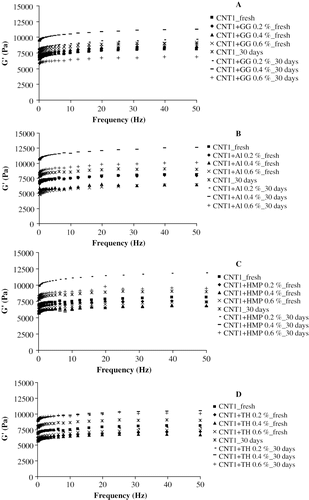
Correlations
Pearson correlation coefficients of amylose, pasting properties, gel texture (hardness) and rheological properties of fresh and reheated gels after storage at −18°C for 30 days are reported in . Significant correlations were obtained for the storage modulus (G′) with peak and set back viscosity. The negative correlation (r = −0.71) of G′ and peak viscosity of fresh rice gels suggests an inverse relationship with weaker structured gels which can be a relatively easy test to implement for screening purposes for selecting potential rice varieties for fresh food applications. G′ was positively correlated to set back viscosity (r = 0.76) of fresh rice gels () which suggests that firmer gels are related to retrograded starch. Gel texture measured as hardness at 70% compression of frozen gels for 30 days at −18°C and reheated was negatively correlated to final and set back viscosity (r = −0.71 and −0.70, respectively) (). It is interesting to note that no significant correlations were found when the gels were tested at 15% compression (). This suggests that this most likely will be revealed during mastication, which uses compression rate more closely related to 70%.
Table 4 Pearson correlation coefficients of amylose content, pasting properties, hardness and rheological properties (at 40 Hz) of fresh gels
Table 5 Pearson correlation coefficients of amylose content, pasting properties, hardness and rheological properties (at 40 Hz) of reheated gel after frozen storage for 30 days
CONCLUSIONS
Quality of many carbohydrate-based food products is related to starch gels including their frozen products. Most frozen products show some quality deterioration due to freezing and frozen storage. This study showed that high amylose rice starch gel had significant increase in gel hardness and were more rigid (increase in G′ and G″) after 30 days of frozen storage. The degree of the changes depended on rice variety. Addition of additives such as alginate, guar gum, high methoxyl pectin, or trehalose resulted in changes of pasting properties of starch, and texture and rheological properties of gels after frozen storage. Guar gum at 0.6% could reduce hardness, and rigidity of frozen gels and 0.4–0.6% high methoxyl pectin could provide stable gel during frozen storage. Complementary studies of changes of glass transition temperature and syneresis during frozen storage will be reported in a separate communication
Acknowledgments
The authors acknowledge the financial support of Postharvest Technology Innovation Center, Khon Kaen University, Thailand, and Food and Agricultural Products and Research Center, Oklahoma State University, OK, USA.
REFERENCES
- Kasikorn Research Center. Rice Products: Export Still Growing. Business Brief No. 1963, 24 January 2007 http://www.kasikornresearch.com/kr/eng/search_detail.jsp?id=8325&cid=4 (Accessed: 7 September 2007 ).
- National Food Institute. Statistic Export-Import of Rice Products (Noodle). 2007, http://www.nfi.or.th/stat/statistic.asp (Accessed: 7 September 2007 ).
- Tatsumi , E. 2005 . Processing of High-Quality Rice Noodles in China . JIRCAS NewsLetter for International Collaboration , 43 : 1 – 8 .
- Noosuk , P. , Hill , S.E. , Pradipasena , P. , John , R. and Mitchell , J.R. 2003 . Structure-Viscosity Relationships for Thai Rice Starches . Starch , 55 ( 8 ) : 337 – 344 .
- Hagenimana , A. , Pu , P. and Ding , X. 2005 . Study on Thermal and Rheological Properties of Native Rice Starches and Their Corresponding Mixtures . Food Res Int. , 38 ( 3 ) : 257 – 266 .
- Chien , J.T. , Lien , Y. -Y. and Shoemaker , C.F. 1999 . Effect of Polarity of Complexing Agents on Thermal and Rheological Properties of Rice Starch Gels . Cereal Chem. , 76 ( 6 ) : 837 – 842 .
- Sodhi , N.S. and Singh , N. 2003 . Morphlogical, Thermal and Rheological Properties of Starches Separated from Rice Cultivars Grown in India . Food Chem. , 80 ( 1 ) : 99 – 108 .
- Jane , J. , Chen , Y.Y. , Lee , L.F. , McPherson , A.E. , Wong , K.S. , Radosavljevic , M. and Kasemsuwan , T. 1999 . Effects of Amylopectin Branch Chain Length and Amylose Content on the Gelatinization and Pasting Properties of Starch . Cereal Chem. , 76 ( 5 ) : 629 – 637 .
- Bao , J. , Sun , M. , Zhu , L. and Corke , H. 2004 . Analysis of Quantitative Trait Loci for Some Starch Properties of Rice (Orysa sativa L.): Thermal Properties, Gel Texture and Swelling volume . J. Cereal Sci. , 39 ( 3 ) : 379 – 385 .
- Sasaki , T. , Yasui , T. , Matsuki , J. and Satake , T. 2002 . Rheological Properties of Mixed Gels using Waxy and Non-Waxy Wheat Starch . Starch. , 54 ( 9 ) : 410 – 414 .
- Varavinit , S. , Shobsngob , S. , Varanyanond , W. , Chinachoti , P. and Naivikul , O. 2002 . Freezing and Thawing Conditions Affect the Gel Stability of Different Varieties of Rice Flour . Starch. , 54 ( 1 ) : 31 – 36 .
- Ferrero , C. , Martino , M.N. and Zaritzky , N.E. 1993 . Stability of Frozen Starch Pastes: Effect of Freezing, Storage and Xanthan Gun Addition . J. Food Proc. and Pres. , 17 ( 3 ) : 191 – 211 .
- Lee , M.H. , Baek , M.H. , Cha , D.S. , Park , H.J. and Lim , S.T. 2002 . Freeze-Thaw Stabilization of Sweet Potato Starch Gel by Polysaccharide Gums . Food Hydrocolloids. , 16 ( 4 ) : 345 – 352 .
- Lai , H.M. and Chung , Y.L. 2001 . Molecular Mobility of Waxy Rice Starch Paste at Low Temperature Studied by using MDSC and NMR . AACC Annual Meeting . Oct 14–18 2001 , North Carolina .
- Kuraoka , N. Frozen Product of Raw or Boiled Noodles of Japanese Buckwheat (Soba) . US Patent 7094436, 2006. Filed: Nov. 1, 2002. Issue dates: Aug. 22, 2006 .
- Juliano , B.O. 1985 . Rice: Chemistry and Technology , 774 St. Paul , Minnesota : American Association of Cereal Chemists .
- Puchongkavarin , H. , Varavinit , S. and Bergthaller , W. July 17–20 2003 . Comparative Study of Pilot Scale Rice Starch Production in An Alkaline and An Enzymatic Process , July 17–20 , Pattaya , , Thailand : Biothailand Technology for Life 2003 .
- AACC International . 2000 . Approved Methods of the AACC International , 10th , St. Paul , Minnesota : AACC Int .
- Juliano , B.O. 1992 . Structure, Chemistry, and Function of the Rice Grain and Its Fractions . Cereal Chem. , 37 ( 10 ) : 772 – 779 .
- Lumdubwong , N. and Seib , P.A. 2000 . Rice Starch Isolation by Alkaline Protease Digestion of Wet-Milled Rice Flour . J. Cereal Sci. , 31 ( 1 ) : 63 – 74 .
- Ellis , R.P. , Cochrane , M.P. , Dale , M.F.B. , Duffus , C.M. , Lynn , A. , Morrison , I.M. , Prentice , R.D.M. , Swanston , J.S. and Tiller , S.A. 1998 . Starch Production and Industrial Use . J. Sci Food Agric. , 77 ( 3 ) : 289 – 311 .
- Bhattacharya , M. , Zee , S.Y. and Corke , H. 1999 . Physicochemical Properties Related to Quality of Rice Noodles . Cereal Chem. , 76 ( 6 ) : 861 – 867 .
- Williams , P.A. and Phillips , G.O. “ Introduction to Food Hydrocolloids ” . In Handbook of Hydrocolloids , Edited by: Phillips , G.O. and Williams , P.A. 1 – 19 . 2000 : Woodhead Publishing Limited: Cambridge .
- Whistler , R.L. and BeMiller , J.N. 1999 . Carbohydrate Chemistry for Food Scientists , 241 Minnesota : Eagan Press .
- Hoffman , A.S. 2001 . Hydrogels for Biomedical Applications . Annals of the New York Academy of Science , 944 : 62 – 73 .
- Biliaderis , C.G. and Juliano , B.O. 1993 . Thermal and Mechanical Properties of Concentrated Rice Starch Gels of Varying Composition . Food Chem. , 48 ( 3 ) : 243 – 250 .
- Reid , D.S. 1990 . Optimizing the Quality of Frozen Foods . Food Technol. , 44 ( 7 ) : 78 – 82 .
- Yoo , D. , Kim , C. and Yoo , B. 2005 . Steady and Dynamic Shear Rheology of Rice Starch- Galactomannan Mixtures . Starch. , 57 ( 7 ) : 310 – 318 .
